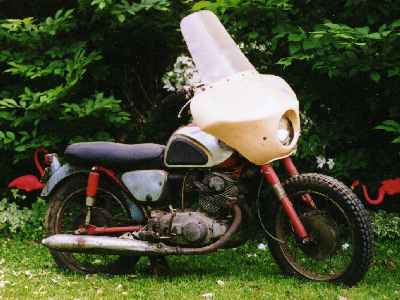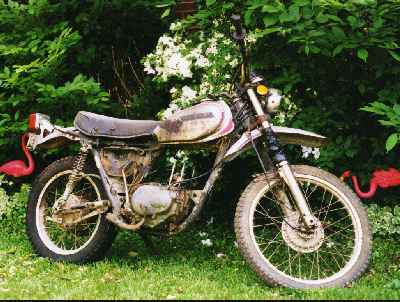
The fifth Honda, of course, is the one I just bought.
This page tells a few things about the other four, two of which I still
own.
 |
Honda #1 is a 1962 CB77 Super Hawk that I bought from Ham's Cycles in Cocoa, Florida. I was stationed at nearby Patrick Air Force Base for my first assignment with the U.S. Air Force. The Super Hawk is the motorcycle that really put Honda on the U.S. motorcycle scene. It lost all the tinny look of previous Hondas and had several features that set it well apart from the very popular British makes in the middleweight motorcycle classes. It had an engine size of 305 cubic centimeter (cc) displacement, a very unusual size. We were accustomed to 125, 250, 500, and 650 cc sizes; and 305 just didn't fit the scheme. Later we found out the original engine design was 250 cc, and the 305 was basically a bored-out 250. This gave it a very over-square bore and stroke.
The real innovation was a 180-degree crankshaft that significantly reduced vibration, but at the same time gave the Super Hawk a very unusual and distinctive sound because the cylinders fired in an uneven rhythm. People accustomed to the even beat of a British vertical twin found it really strange. But we got used to it. The Super Hawk also had an electric starter, which became standard on almost all Japanese motorcycles.
The Super Hawk attained a surprising amount of power for its size, mainly from a 10.5-to-1 compression ratio, overhead camshafts, and unheard-of RPMs for a stock engine. As sold, it peaked out at about 10,000 RPM. Later, it reached its full potential at 11,500 RPM. Reason for the change was that the original Japanese valve springs were weak. In 1962 Japan's steel industry had not yet perfected the technology of high strength spring steel. The original clutch springs also turned out to be weak. Under the warranty, Ham's Cycles replaced both the valve springs and the clutch springs with American steel equivalents. The difference was almost shocking. The motor was quite ordinary at 4000 RPM and below. It gave a distinct surge of power at 4000 RPM that continued to 6000. Then another surge yanked you forward up to 11,000 RPM, which was about 60 miles per hour in second gear.
This Super Hawk retired in 1970 when I bought the 350 cc Yamaha twin, but I still have her and she is close to running condition. I last ran her in 1987 on a ride around the Capital Beltway at Washington, DC. She has about 95,000 miles and many original parts. But over the years I replaced pistons, camshafts, valves, cam chain, crankshaft bearings, alternator stator, seat, swingarm bearing, and rear shocks. Incredibly, the clutch is all original parts.
Interesting side note. When the first Honda automobile appeared in Los Angeles in 1971, a peek under the hood revealed a 700 cc two-cylinder motor that was the spitting image of the 305 cc Super Hawk's motor. Many features were identical. A fitting tribute, indeed, to the motorcycle that kicked off the Japanese revolution in American motorcycling. And also, apparently, the American automobile experience as well.
Honda #2 was a 1967 CL90L converted to a trail bike. I bought it in Thousand Oaks, California, in 1970, and used it for trail riding in California and Colorado until 1973. I rode it very, very hard. Broke the clutch once. After a while I put an oversize piston and a hot cam in it for a little more oomph. In 1972 I successfully took it up the Annual Pikes Peak New Year's Day Motorcycle Run. Out of about 400 entries, it was nearly the last motorcycle to reach the top, leaving about 75 behind that did not. Near the top it would only go 30 miles per hour (mph) against the 40 mph head winds at 38 below zero Fahrenheit. Don't worry; we were all dressed for it. Quite a day.
I cut my trail riding teeth on the CL90 and only retired it when I had learned all I could about trail riding at the 90 cc level.
Honda #3 was a 70 cc minibike. My sons and
neighbor kids had countless hours of fun with this little bike. When
he was eleven, my oldest boy rode it over the Continental Divide at Cottonwood
Pass, Colorado. In six years the only repairs I ever did to it was
a valve job. It's probably still running somewhere.
 |
Honda #4 is a 1972 XL250. When I decided to buy a bigger trail bike in 1973, the Honda dealer wouldn't accept my Yamaha 350 road bike in trade, so I bought a 250 cc Yamaha DT1, one of the most popular trail bikes at that time. Less than two months later someone stole it from the parking lot at Headquarters North American Air Defense Command in Colorado Springs, Colorado. With the insurance I bought the Honda XL250, which is what I really wanted in the first place. This was my main motorcycle from 1973 until 1986, when some teenagers stole it from my front yard. I recovered it, but the crankshaft bearing was damaged and I couldn't afford to fix it at the time.
The XL250 has an overhead camshaft and four valves, with a centrally located spark plug. It is surprisingly strong and has a very broad power band. My neighbor in Colorado Springs had a Yamaha 360, a fairly powerful trail bike. The XL250 beat it every time in straight acceleration, the key being the broad power band. The Yamaha would have to shift two times while the XL250 was pulling away strongly in second gear.
In the picture, the XL250 is missing its cylinder and head, removed to verify the worn out crankshaft bearing. I hope to restore it someday.
In those thirteen years I rode the XL250 over thousands
of miles of Colorado and Virginia trails, plus three weekends around Albuquerque,
New Mexico. I also used it to commute to work, both in Colorado Springs
and in the Washington, DC, area. It simply ran and ran and ran.
Two times up the Annual Pikes Peak New Year's Day Run, and over the Continental
Divide at Cottonwood Pass, Colorado, too. My experience with this
motorcycle convinced me that single-cylinder four-stroke motorcycles are
what I like.
|
|
|
(c) Copyright 2000 Don Wilkins All rights reserved.